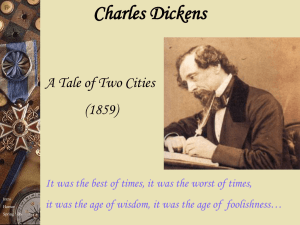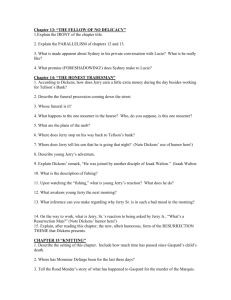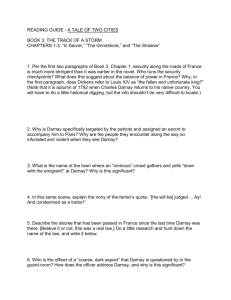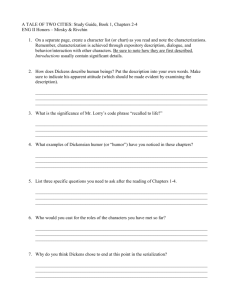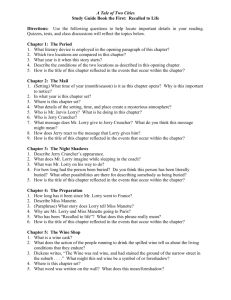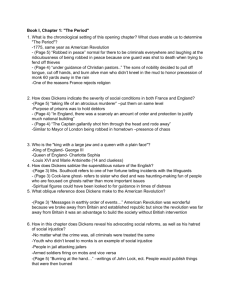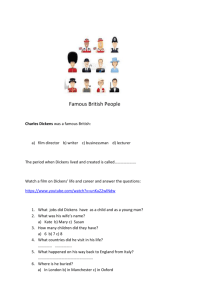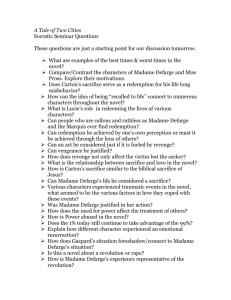Book I: "Recalled to Life"
advertisement
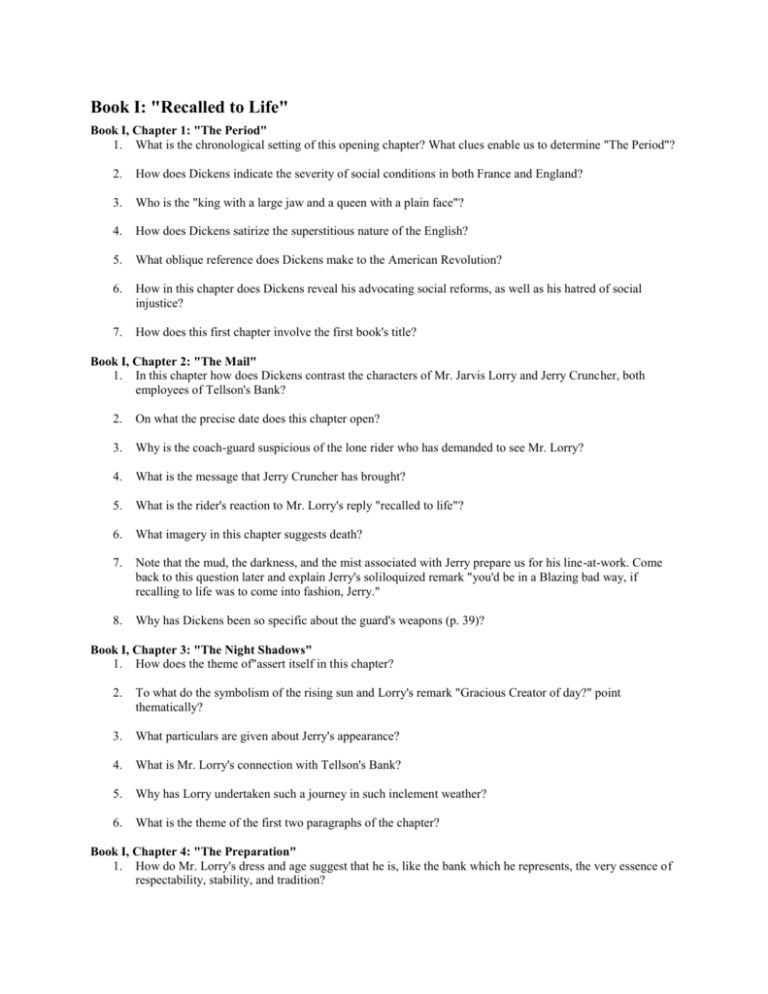
Book I: "Recalled to Life" Book I, Chapter 1: "The Period" 1. What is the chronological setting of this opening chapter? What clues enable us to determine "The Period"? 2. How does Dickens indicate the severity of social conditions in both France and England? 3. Who is the "king with a large jaw and a queen with a plain face"? 4. How does Dickens satirize the superstitious nature of the English? 5. What oblique reference does Dickens make to the American Revolution? 6. How in this chapter does Dickens reveal his advocating social reforms, as well as his hatred of social injustice? 7. How does this first chapter involve the first book's title? Book I, Chapter 2: "The Mail" 1. In this chapter how does Dickens contrast the characters of Mr. Jarvis Lorry and Jerry Cruncher, both employees of Tellson's Bank? 2. On what the precise date does this chapter open? 3. Why is the coach-guard suspicious of the lone rider who has demanded to see Mr. Lorry? 4. What is the message that Jerry Cruncher has brought? 5. What is the rider's reaction to Mr. Lorry's reply "recalled to life"? 6. What imagery in this chapter suggests death? 7. Note that the mud, the darkness, and the mist associated with Jerry prepare us for his line-at-work. Come back to this question later and explain Jerry's soliloquized remark "you'd be in a Blazing bad way, if recalling to life was to come into fashion, Jerry." 8. Why has Dickens been so specific about the guard's weapons (p. 39)? Book I, Chapter 3: "The Night Shadows" 1. How does the theme of"assert itself in this chapter? 2. To what do the symbolism of the rising sun and Lorry's remark "Gracious Creator of day?" point thematically? 3. What particulars are given about Jerry's appearance? 4. What is Mr. Lorry's connection with Tellson's Bank? 5. Why has Lorry undertaken such a journey in such inclement weather? 6. What is the theme of the first two paragraphs of the chapter? Book I, Chapter 4: "The Preparation" 1. How do Mr. Lorry's dress and age suggest that he is, like the bank which he represents, the very essence of respectability, stability, and tradition? 2. How is Dickens' 1859 infatuation with a young, blonde, blue-eyed actress named Ellen Ternan reflected in this chapter? 3. Why does the brawny, red-haired woman get so angry at Mr. Lorry? 4. Why had Mrs. Manette maintained the fiction for Lucy that her father was dead? 5. How does this chapter elucidate Lorry's enigmatic message to Jerry? 6. What detail in Dickens' portrait of the "wild-looking woman" is at once imposing yet humourous? Book I, Chapter 5: "The Wine-Shop" 1. Compare the scene of the broken wine cask with that of the Royal George at Dover in the previous chapter. What does "this wine game" (p. 60) FORESHADOW? 2. Why did the wine-seller, Ernest Defarge, admonish Gaspard by placing his hand on the prankster's heart? 3. How are the inhabitants of St. Antoine both literally and figuratively "gaunt scare crows"? 4. How are Ernest and Madame Therese Defarge different from the frenzied rabble in their street? 5. Why does Defarge exhibit Dr. Manette to a chosen few? 6. What is the significance of Madame Defarge's knitting? 7. Why does Defarge feel that Lorry could not understand why he shows the sorry spectacle of Dr. Manette to fellow Jacques? 8. Check the Penguin text's note on the Faubourg Saint Antoine (p. 405): why has Dickens chosen to make this slum area he setting for this chapter and our first glimpse of the novel's "second" city and of French society? 9. Why do Defarge and his friends call each other "Jacques" when his Christian name is "Ernest"? 10. The French King, Louis XVI, though honest and well-meaning, had neither the ability for nor an interest in politics and lost himself in an obsession for locksmithing, hobby far below his social station. What is comparable in the wasted Dr. Manette? Book I, Chapter 6: "The Shoemaker" 1. How do we know that nothing really misses the eyes and ears of Madame Defarge? 2. Why did Dr. Manette give his name as "One Hundred and Five, North Tower" (p. 73)? 3. Why is Manette's voice "pitiable and dreadful"? 4. Where apparently does Manette believe himself to be? 5. What connection between Lucy and his own past does Dr. Manette make? 6. How does Defarge's part in getting Mr. Lorry and the Manettes out of Paris indicate his knowledge of the workings of the acienne regime? 7. How is the conclusion of the first book both pathetic and comic? Book II: "The Golden Thread" (For Discussion) Since there are twenty-four chapters in this section of the novel, we cannot study these in the same detail as we did the highly-significant, first six expository chapters. Please continue to read the notes in the back of the book, such as that on Temple Bar (p. 406). In "The Golden Thread," which opens in London five years after Dr. Manette's escape from France, Dickens satirizes English justice (which Temple Bar indicates was not nearly so enlightened as Dickens's Middle Class readers liked to imagine), lawyers, and courts of law, all of which Dickens knew from his father's imprisonment for debt in 1824 at Marshalsea (notoriously depicted in Little Dorrit, 1855-7), from his own employment at the age of 15 as a lawyer's clerk, and from his stint as a shorthand reporter in the Courts of Doctors (of Law) Commons. The Pickwick Papers (1837), David Copperfield (1849-50), Bleak House (1852-3), and the novel following A Tale of Two Cities, Great Expectations (1861), all reveal Dickens's first-hand knowledge of the British legal system (and generally reflect his contempt for it). In the second book Dickens divides his time almost evenly between France and England, but clearly it is France's political, economic, and especially its social problems that fascinate him. Contrast the French system of "justice," as presented in Book One, with that of England, as given in Book Two. Book II, Chapter 1: "Five Years Later" 1. How does his description of Tellson's Bank suggest Dickens' characteristic over-writing? 2. Jerry Cruncher is the only character reminiscent of the broadly-drawn comic caricatures that figure so prominently in his early novels: how is he both comic and yet consistent with Dickens' attack on social conditions? 3. How do Jerry's hands and boots constitute a mystery? 4. How does Tellson's epitomize English complacency? Book II, Chapter 2: "A Sight" 1. How is Dickens critical of both the Old Bailey and Bedlam? 2. Why are the Manettes in court? 3. What punishment is meant by "quartering"? 4. For what crime is the punishment reserved? 5. See the note on the source of this trial on p. 406 (#15). Cutting out the bombast, what precisely is the charge levelled at Darnay? 6. What changed impression do we get of Dr. Manette? Book II, Chapter 3. "A Disappointment" 1. How does Stryver discredit the prosecution's first witness, John Barsad? 2. What are the incriminating circumstances under which Darnay had travelled back and forth from England to France? 3. What is suspicious about the Crown's evidence? 4. How does Roger Cly's testimony seem more conclusive? 5. However, what inconvenient facts discredits Cly? 6. Lorry's testimony merely establishes that Darnay was on the Dover-Calais packet; what damage does Lucy's do? 7. How does Stryver confuse the witness who testifies to Darnay's being "in that garrison-and-dockyard town" (p. 103)? Book II, Chapter 4: "Congratulatory" 1. What negative impressions do we get of Carton? 2. We note that Dr. Manette's "face had become frozen . . . in a very curious look at Darnay: an intent look, deepening into a frown of dislike and distrust, not even unmixed with fear" (p. 112). What two devices is Dickens using here? 3. What suggestion does Dickens implant in the reader's mind by the closing line of this chapter? Book II, Chapter 5: "The Jackal" 1. What is the relationship between the so-called Jackal and Lion? Book II, Chapter 6: "Hundreds of People" 1. Why is Miss Pross jealous of Darnay and Carton? 2. How is the incident alluded to in question 2, Chapter 4, repeated and yet also augmented here? 3. What do the echoing footsteps foreshadow? Book II, Chapter 7: "Monseigneur in Town" 1. Why does Dickens heap verbally ironic sarcasm (e.g., "his sanctuary of sanctuaries" on p. 134) on Monseigneur? 2. Why had Monseigneur taken his sister from a convent and married her off (below her social station) to a very rich Farmer-General? 3. What is the moral climate created by Monseigneur's guests? 4. How does the Marquis rationalize the accident? 5. In classical myth the three Fates spun, wove, and cut the thread of a person's life -- how does Dickens connect Madame Defarge with these supernatural beings from the accident scene to the end of the chapter? Book II, Chapter 8: "Monseigneur in the Country" 1. The setting sun's blush on the Marquis' face suggests what fate awaits him? 2. What accounts for the apathetic conditions of the crops, the village, and its people? 3. In the last chapter the Marquis thought of the peasants as rats and dogs, and here he addresses the roadmender as "pig" (p. 145) why is his rudeness ironic here? 4. How does this chapter confirm a connection between Charles and the Marquis? Book II, Chapter 9: "The Gorgon's Head" In classical myth the gorgons were creatures so repulsive that the very sight of one would turn the beholder to stone -- indeed, the hero Perseus uses the head of the gorgon Medusa, whom he has slain by looking into his polished shield rather than directly at her, to turn the Titan Atlas into a mountain (Gibraltar). 1. How does this title seem appropriate for the chapter? Consider pages 149, 151, and 159 especially. 2. Though closely related, how do the Marquis and his nephew from England radically differ? 3. What intentions does the Marquis imply he has towards Dr. Manette and to his nephew? 4. How does the note around the murder weapon explain why the Marquis was killed? 5. Why is the Marquis, uncle to Charles Darnay, actually his enemy? Book II, Chapter 10: "Two Promises" 1. What is the chronological setting relative to Chapter 9? 2. How does Darnay, having renounced his family inheritance, earn his living? 3. Why is it ironic that Dr. Manette refuses to listen when Charles tries to tell him his real name? 4. Why does the Doctor suffer a relapse and return to his cobbler's bench? 5. What is particularly noble about Charles' profession of love for Lucie, made to her father? Book II, Chapter 11: "A Companion Picture" 1. Why does Stryver continually criticize and belittle Sydney Carton for his social lapses? 2. Why does Carton endure such abuse? 3. In what sense is this chapter's title ironic? 4. How does Dickens suggest the cause of Carton's alcoholism? Book II, Chapter 12: "The Fellow of Delicacy" 1. Why does Dickens have Mr. Lorry rather than Lucie herself reject Stryver's repulsive, egotistical absurd proposal? 2. Why did Stryver go to Mr. Lorry before actually proposing? Book II, Chapter 13: "The Fellow of No Delicacy" 1. Why does Dickens call Carton ironically "the fellow of no delicacy"? 2. How is Sydney Carton's love for Lucie somewhat akin to Charles Darnay's? NOTE: The foreshadowing in "I would embrace any sacrifice for you and for those dear to you." (p. 183) is obvious. The extreme sentimentality of such writing greatly appealed to Victorian, female readers, who saw Carton as a kind of romantic Hamlet or another Heathcliff (from Emily Bronte's Wuthering Heights). Book II, Chapter 14: "The Honest Tradesman" 1. From whose point of view is the narrative of this chapter given? 2. What is the technical name for a fiction which describes the coming of age of a young person, a work such as Oliver Twist, David Copperfield, or Great Expectations? What characteristics of this chapter have the same quality? 3. How is this chapter's title ironic? 4. Although we might momentarily feel that Jerry's boxing his son's ears for whooping at the prospect of a funeral stemmed from the father's sense of social propriety, what probably was the real reason for his hushing up his son? 5. Why is the crowd following the funeral procession incensed? 6. Although this mob is genial, its feelings against the establishment run as deep as those of the denizens of St. Antoine, how is the senseless violence of the Revolution foreshadowed here? 7. Why is Cly's having been "a young 'un and a straight made 'un" (p. 188) of specific significance for Jerry? 8. How does Jerry apparently dispose of his windfall income? 9. Before we actually see Jerry in his true professional capacity, what clues does Dickens provide to add suspense? 10. Give three examples of humourous verbal irony from the bottom of page 190. 11. Although we do not see the conclusion of the fishing expedition, how do we know something has gone wrong? 12. What purpose to the main plot of the book does this chapter serve? Book II, Chapter 15: "Knitting" 1. What two mysteries are resolved for us in this chapter? 2. Why are the Defarges cheered by the opulence of the Versailles court? 3. Who are Jacques Four and Five? 4. How does the road-mender characterize the grandees of the court? Book II, Chapter 16: "Still Knitting" 1. The success of the Revolution seems assured because there are Jacques in the strategic government offices -- give an example. 2. Why does Defarge not answer to the name "Jacques" when greeted by the stranger in the wineshop? 3. What information given by Barsad strongly affects the Defarges, but differently? Book II, Chapter 17: "One Night" 1. How will the new domestic arrangement for the Manettes resolve the problem of Charles' love for Lucie separating her from her father? Book II, Chapter 18: "Nine Days" 1. Who is to look after Dr. Manette while the young couple are away on their honeymoon? 2. Why does the Doctor emerge from his conference with the bridegroom deathly pale? 3. How does Dickens employ Dr. Manette's relapse to generate suspense? Book II, Chapter 19: "An Opinion" 1. What request of Dr. Manette, now recovered, does Mr. Lorry make and why? 2. Once again Dickens employs Lorry to relate a difficult truth: what was the first occasion? How does Lorry handle it each time? Book II, Chapter 20: "A Plea" 1. In spite of his own unhappy marriage, or perhaps because of it, how does Dickens characterize the Charles/Lucie relationship? 2. Why, surprisingly, does Sydney Carton apologize to Charles and offer his friendship? Book II, Chapter 21: "Echoing Footsteps" 1. What is the date in this chapter? 2. What is Carton's relationship with the Darnay family? 3. How does Mr. Lorry's news indicate the revolution is beginning? 4. How do we finally get to see Dr. Manette's place of confinement in the Bastille? 5. How does Dickens intensify our repulsion for Madame Defarge? Book II, Chapter 22: "The Sea Still Rises" 1. What is the date now? 2. Why does Defarge hate Foulon? 3. How is Foulon's punishment yet another example of poetic justice? 4. When Defarge says to his wife "At last it has come," why does she not totally agree? Book II, Chapter 23: "Fire Rises" 1. What was the significance of the blaze the stranger made in his pipe? 2. Whom do the four fierce figures come to represent in this chapter? 3. Why can the rider solicit no aid from any quarter? Note that Gabelle ("Mr. Salt Tax") miraculously escapes. Book II, Chapter 24: "Drawn to the Loadstone Rock" 1. What is the chronological setting? 2. Why is Lorry going to Paris? 3. Why does Charles offer to go in his place? 4. How does Dickens use the letter to the Marquis de Evremonde to generate suspense? 5. Why does Gabelle request Charles to return to France? 6. The Loadstone Rock was a mythical rock that magnetically drew ships to it so that they would crash -what for Charles is the Loadstone Rock? 7. Why was Tellson's Bank, London, the natural gathering place of the emigres? 8. Should Darnay have kept his real name and identity secret from his wife, and not told her of his trip? 9. Why is it ironic that Gabelle is being held in the Abbaye? 10. Why does Darnay unwisely feel that it is safe for him to return to assist Gabelle? 11. Why does he feel he must help him? Book III: "The Track of a Storm" In these final fifteen chapters Dickens focuses on the Reign of Terror (September, 1792 to September, 1793, precipitated by the excesses of the aristocracy in the preceding century, especially of the Sun King, Louis XIV, who is reputed to have said shortly before his death in 1715, "Apres moi, le deluge." In October, 1789, several thousand women marched on Versailles, demanding that Louis XVI move to Paris. In February, 1790, the King accepted the principles of the Revolution, which heretofore had been democratic but disorganised. In September, 1791, after unsuccessfully attempting to flee France, the King accepted the work of the Assembly, and, with the concurrence of the Girondists in its successor, the Legislative Assembly, declared war against Austria in April, 1792. However, sensing the King was now a liability in a war being waged against France by monarchist regimes in Austria and Prussia, the Parisian mob attacked the Palace of the Tuileries in August. Under the Revolutionary Tribunal over 1,200 political prisoners perished in the infamous September Massacres. The National Convention, which then replaced the Legislative Assembly, sentenced the King to death in January, 1793; in October, his wife, the beautiful Queen Marie Antoinette, followed him to the guillotine. In July, 1794, the Reign of Terror burned itself out with the execution of the last of the Revolution's great butchers, Robespierre. The stage was set for Napoleon. In 1792 France was in danger and there really were traitors, starting with the King and Queen, who had encouraged the intervention of outside powers. France was fighting for her life against the forces of ancient corruption; and for a few years her leaders suffered from the most terrible of all delusions. They believed themselves to be virtuous. Robespierre's friend St. Just said, "In a republic which can only be based on virtue, any pity shown towards crime is a flagrant proof of treason" (Kenneth Clark, Civilisation, "Fallacies of Hope"). Clark's "Worship of Nature," "The Smile of Reason," and "Fallacies of Hope," all of which cover the historical background to the French Revolution, are worth viewing. Students should compare Dickens' description of the death of the maniacal Madame Defarge to David's painting "Marat Murdered in his Bath." Book III, Chapter 1: "In Secret" 1. How does Charles come to realize the extreme danger he's placed himself by returning to France at this time? 2. What is the full significance of the chapter's title? 3. Of what is Charles reminded as he paces to and fro in his cell in La Force? 4. Under what charges has Charles been imprisoned? 5. How does our attitude towards Ernest Defarge change in this chapter? Book III, Chapter 2: "The Grindstone" 1. How is Lorry's exclamation, "Thank God that no one near and dear to me is in this dreadful town tonight" ironic? 2. How does the scene with the grindstone considerably heighten the suspense? 3. Why do the savagely anti-aristocratic patriots agree to help Dr. Manette? Book III, Chapter 3: "The Shadow." 1. Why does Lorry find the situation doubly distressing? 2. Why does Madame Defarge coldly scrutinize Charles' family? Book III, Chapter 4: "Calm in Storm." 1. How many months are covered in this chapter? 2. Why do all the atrocities he witnesses not drive Dr. Manette into another relapse? 3. In fact, our estimation of Dr. Manette changes, and he becomes a developing character. Justify or attack Dickens' treatment of Dr. Manette's character in this chapter. 4. Note Dickens' allusion to the children of the dragon's teeth (p. 301), the tough, new generation that were to populate Cadmus' new city, Thebes, in Ovid's Metamorphoses. Why does he so refer to the patriots? 5. Explain: "La Guillotine . . . was the sign of regeneration of the human. It superseded the cross" (p. 302) AND "The name of the functionary . . . every day" (p. 303). Book III, Chapter 5: "The Wood-Sawyer" 1. What is coincidental about the wood-sawyer who lives in the vicinity of La Force? 2. What is the Carmagnole? 3. Who is in secret conference with Mr. Lorry? 4. What is ominous in the wood-sawyer's personifying himself as "the Samson of the firewood guillotine"? (p. 306)? 5. How do we become aware acutely that this novel was originally serialized when we get to the end of this chapter? Book III, Chapter 6: "Triumph" 1. Why does the attitude of the crowd of the courtroom to Charles dramatically change? 2. Who are Charles' principal witnesses? 3. What does their testimony substantiate? 4. As a discerning reader, why do you find Charles' exoneration unsatisfying? Book III, Chapter 7: "A Knock at the Door." 1. Upon what grounds is Charles again arrested on the afternoon of his release? 2. What foreshadowing of Charles' arrest does Dickens initially provide? 3. How did Miss Pross always get bargains when shopping despite her total lack of French? What is her attitude towards the French language? Book III, Chapter 8: "A Hand at Cards." 1. What great coincidence is revealed to us, Miss Pross, and Jerry Cruncher in the wine-shop when they are out on their usual afternoon shopping expedition? 2. Why has Sydney Carton come to Paris? 3. What damaging evidence does Carton hold against Barsad? 4. What evidence does Carton not possess which would be even more damning against Barsad? Book III, Chapter 9: "The Game Made" 1. How does the identity of Charles' third accuser come as a less-than-total surprise? 2. How does Jerry use his insights into society's double standards to defend himself from Lorry's anger? 3. What details concerning Sydney Carton1s thoughts and activities, build suspense? 4. How does Carton's touching conversation with Lorry give us the impression that Carton has had a premonition of death? Note the significance of Carton's speaking French like a native (p. 341). Book III, Chapter 10: "The Substance of the Shadow." 1. Here Dickens employs a first person, major character, inset narrative, a flashback in the epistolary mode: apply each of these terms to pages 348-349. 2. Where and how was the letter written (we here recall that Charles, imprisoned also in secret, was not permitted pen and paper by the new but equally vicious regime (see p. 286)? 3. How does the number two figure prominently in the Doctor's narrative of the mad woman and her dying brother (ultimately revealed as the brother and sister of Madame Defarge)? 4. Since Charles had nothing to do with this double crime, why is Madame Defarge bent on his destruction? 5. Even though his letter ends with a repeat of the curse on the Evremonde family, how does it also explain Charles' very different nature? 6. What atrocities, typical of the more decadent land-owners, do the Evremondes commit in this chapter? Book III, Chapter 11: "Dusk." As Sydney Carton kisses little Lucie to comfort her distress at her mother's extreme agitation after the trial, he murmurs words that only she hears: "A life you love." 1. The reader, recalling the conclusion of Carton's profession of love for Lucie in Chapter 13 of the Second Book, will conclude what about Carton's plans? 2. To whom may Carton be referring in the closing lines of the chapter? Book III, Chapter 12: "Darkness." 1. What were Carton's intentions in going to Defarge's wineshop? 2. What suspicion does Madame Defarge, in conversation with the Vengeance and Jacques Three, confirm for us? 3. Why has Dr. Manette experienced a profound relapse? 4. What were the two certificates which Carton left in Larry's care? 5. Why is Madam Defarge bent on denouncing even little Lucie? Book III, Chapter 13: "Fifty-two." 1. Although his three letters indicate the people most on his mind as he awaits execution, whom ironically does he not even recall? What KIND of irony is this? 2. Who assists Carton to enter Charles' cell? 3. Charles is reluctant to escape at the cost of Sydney's life: how does Carton force his compliance? 4. What is the significance of the chapter's title? 5. Why does Dickens abruptly shift to the first person plural at the end of this chapter? 6. In the range of prisoners on p. 376, Dickens gives one whose death at the hands of the revolutionary patriots is merely nemesis, and another whose death is totally undeserved, showIng how unjust the Revolution has become. Who are these two? 7. List several sources of suspense in this chapter. Book III, Chapter 14: "The Knitting Done" 1. Why has Madame Defarge deliberately excluded her husband from her conference with the Vengeance and Jacques Three? 2. Why had Miss Pross and Jerry Cruncher been left behind? 3. What extra dimension does the destined confrontation between Miss Pross and Madame Defarge gain by their failIng to understand each other by virtue of their ignorance of the other's language? 4. Why is Madame Defarge's going to Lucie prior to denouncing her for "plotting" not wholly credible? 5. In what ways does the reader sense that the revolutionary zealots are going too far in redressing the injustices of the old regime? Book III, Chapter 15: "The Footsteps Die Out for Ever" 1. After the montage of Madame Defarge's approaching Miss Pross, the climatic meeting, and the unexpected consequences of the struggle, the little scene between Miss Pross and Jerry has provided some comic relief. Does this chapter contain the novel's climax, or merely its denouement? Explain. 2. Who follows the scene of Carton's being driven off to execution with nearly as much apprehension as the reader's? 3. What do Miss Pross and Sydney Carton now clearly have in common? 4. How does the word "wine" in this chapter's second line operate on the reader at a number of levels? 5. What warning does Dickens once again issue to humanity in general, and English society in particular, about the atrocities of the French Revolution? 6. In the seamstress's last remarks (p. 402) we come to certain equations: whom does Dickens mean us to take Carton and his persecutors for (consider also the bottom of p. 403)? 7. How does the novel's theme underscore the theme of resurrection?
